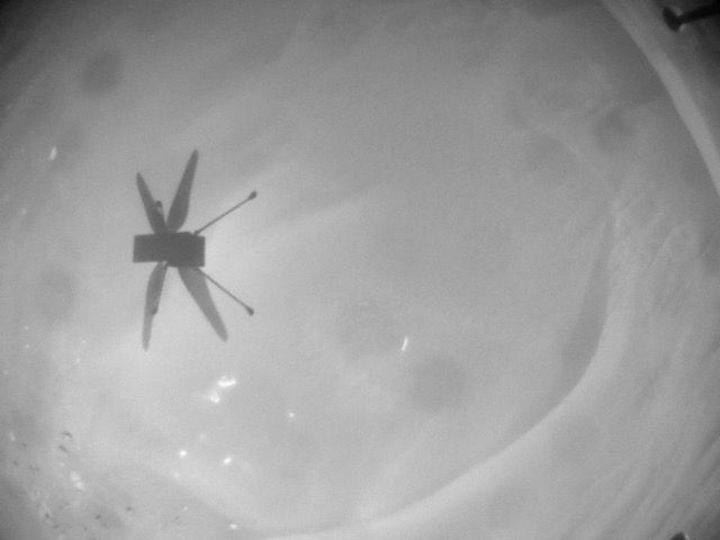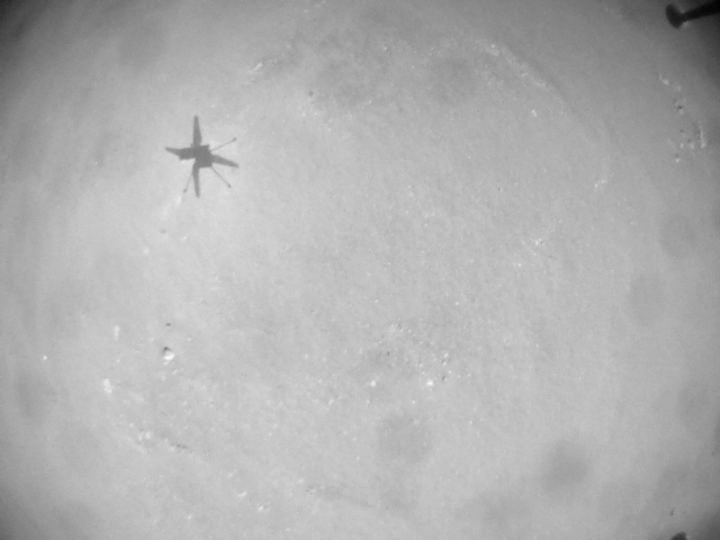17.03.2022
NASA's Perseverance Mars rover nabs 8th rock sample on the Red Planet
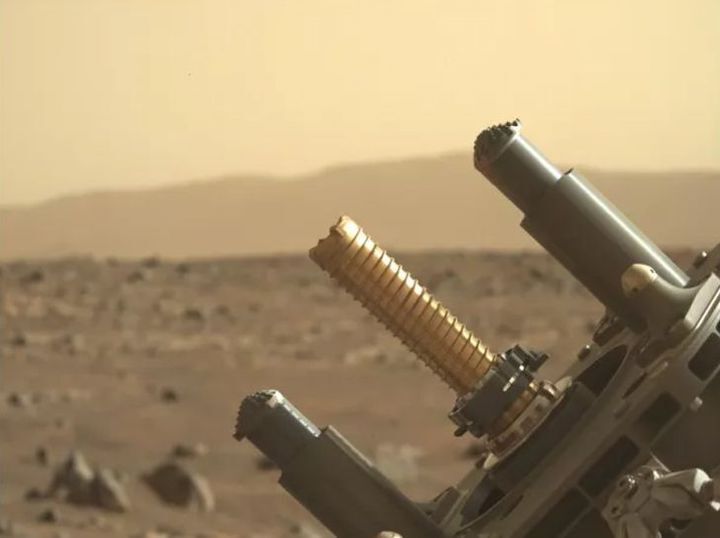
Perseverance's collection system on Mars, photographed as the rover captured its eighth Red Planet sample in March 2022. (Image credit: NASA/JPL-Caltech)
NASA's top-notch Red Planet geology rover is moving on to explore an ancient river delta now that its eighth rock sample is secured for future analysis.
"Stashing my latest rock core sample (#8!) and finishing up at this location. I’m packing up and making my way to the dry river delta. Off we go," the rover's Twitter account stated Monday (March 14).
The Perseverance rover is on a long-term quest to better understand the potential for Mars life. While other Mars missions are searching for signs of water, the rover is going a step further by caching the most promising rocks for a sample-return mission that NASA and its European counterpart intend to launch later this decade.
Perseverance landed in February 2021 in the 28-mile-wide (45 kilometers) Jezero Crater. Mission scientists believe that billions of years ago, the crater held a lake and a river delta, making it a rich hunting ground to sample for potential signs of ancient life.
Perseverance spent most of its first (Earth) year on Mars exploring a region somewhat south and west of its landing site. Now the rover is en route back to the touchdown area to pick up the search at the ancient delta. Stashing my latest rock core sample (#8!) and finishing up at this location. I’m packing up and making my way to the dry river delta. Off we go! #SamplingMars pic.twitter.com/hgdT7jcRByMarch 14, 2022
"There we will have the opportunity to investigate sedimentary rock layers, clay minerals, and rounded boulders washed down from far beyond Jezero. These features are vestiges of Jezero's watery past and clear indicators of an ancient habitable environment," Brad Garczynski, a student collaborator at Purdue University, wrote on the official Perseverance blog March 4.
"If microbial life did exist here in the past," Garczynski continued, "this is one of the best places to look for it, as finely layered muds may have buried and preserved a record of that microbial activity."
Perseverance has been scouting ahead using its Mastcam-Z and SuperCam instruments to pick up signs of the structure and minerals of the delta. Team members will use this data, along with orbital passes over the delta, to scout the pathway for Perseverance in the coming weeks and months.
Another helper has been Ingenuity, the 4-pound (1.8 kilograms) helicopter that landed with Perseverance in 2021. Ingenuity now has 21 flights under its belt at Mars, exceeding its original flight plan by fourfold. With Ingenuity's ability to fly well proven, the little chopper is now serving as a scout for Perseverance's activities.
The sample return mission, assuming things stay on track, may ferry Perseverance's carefully collected samples to Earth as early as 2031.
Quelle: SC
+++
NASA Extends Ingenuity Helicopter Mission
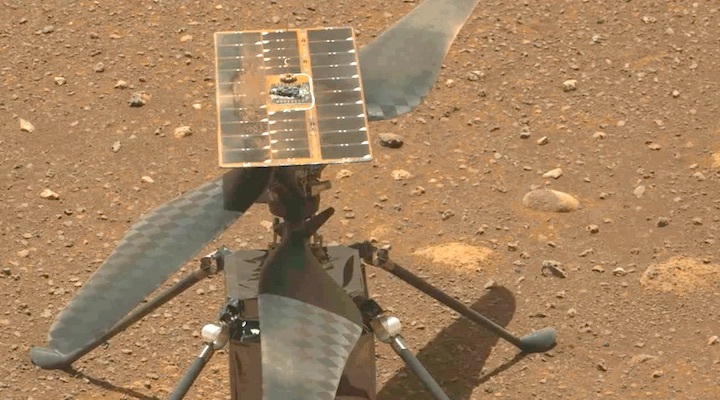
The Ingenuity Mars Helicopter’s carbon fiber blades can be seen in this video taken by the Mastcam-Z instrument aboard NASA’s Perseverance Mars rover on April 8, 2021, the 48th Martian day, or sol, of the mission. They are performing a wiggle test before the actual spin-up to ensure they were working properly. Credit: NASA/JPL-Caltech/ASU
With its recent 21st flight complete, the Red Planet rotorcraft is on its way to setting more records during its second year of operations.
NASA has extended flight operations of the Ingenuity Mars Helicopter through September. In the months ahead, history’s first aircraft to operate from the surface of another world will support the Perseverance rover’s upcoming science campaign exploring the ancient river delta of Jezero Crater. Along the way, it will continue testing its own capabilities to support the design of future Mars air vehicles.
The announcement comes on the heels of the rotorcraft’s 21st successful flight, the first of at least three needed for the helicopter to cross the northwest portion of a region known as “Séítah” and reach its next staging area.
“Less than a year ago we didn’t even know if powered, controlled flight of an aircraft at Mars was possible,” said Thomas Zurbuchen, the associate administrator of NASA’s Science Mission Directorate. “Now, we are looking forward to Ingenuity’s involvement in Perseverance’s second science campaign. Such a transformation of mindset in such a short period is simply amazing, and one of the most historic in the annals of air and space exploration.”
NASA’s hard at work on the Red Planet. Watch the latest Mars Report for more on Ingenuity, along with the agency’s Perseverance and Curiosity rovers.
Ingenuity’s new area of operations is entirely different from the modest, relatively flat terrain it has been flying over since its first flight last April. Several miles wide and formed by an ancient river, the fan-shaped delta rises more than 130 feet (40 meters) above the crater floor. Filled with jagged cliffs, angled surfaces, projecting boulders, and sand-filled pockets that could stop a rover in its tracks (or upend a helicopter upon landing), the delta promises to hold numerous geologic revelations – perhaps even the proof necessary to determine that microscopic life once existed on Mars billions of years ago.
Upon reaching the delta, Ingenuity’s first orders will be to help determine which of two dry river channels Perseverance should take when it’s time to climb to the top of the delta. Along with routing assistance, data provided by the helicopter will help the Perseverance team assess potential science targets. Ingenuity may even be called upon to image geologic features too far afield (or outside of the rover’s traversable zone), or perhaps scout landing zones and caching sites for the Mars Sample Return program.

NASA’s Ingenuity Mars Helicopter acquired this image in the northwest portion of a region known as “Séítah” using its high-resolution color camera during its 20th flight on Feb. 25, 2022.
“The Jezero river delta campaign will be the biggest challenge the Ingenuity team faces since first flight at Mars,” said Teddy Tzanetos, Ingenuity team lead at NASA’s Jet Propulsion Laboratory in Southern California. “To enhance our chances of success, we have increased the size of our team and are making upgrades to our flight software geared toward improving operational flexibility and flight safety.”
Higher Flights
Several of these upgrades have led to reduced navigation errors during flight, which increases both flight and landing safety. A recent software change already on the rotorcraft frees Ingenuity from its previously programmed maximum altitude of 50 feet (15 meters). The altitude gains could result in incremental increases in both air speed and range. A second upgrade allows Ingenuity to change airspeed as it flies. Another enables it to better understand and adjust to changes in terrain texture during flight. Future software upgrades may include adding terrain elevation maps into the navigation filter and a landing-hazard-avoidance capability.

This annotated image depicts the multiple flights – and two different routes – NASA’s Ingenuity Mars Helicopter could take on its trip to Jezero Crater’s delta.
Before aerial reconnaissance of the delta can begin, Ingenuity has to complete its journey to the area. Scheduled for no earlier than March 19, Ingenuity’s next flight will be a complex journey, about 1,150 feet (350 meters) in length, that includes a sharp bend in its course to avoid a large hill. After that, the team will determine whether two or three more flights will be required to complete the crossing of northwest Séítah.
The first experimental flight on another world took place on April 19, 2021, and lasted 39.1 seconds. After another four flights, six more minutes in the air, and traveling a total distance of 1,637 feet (499 meters), NASA transitioned Ingenuity into an operations demonstration phase, testing its ability to provide an aerial dimension to the Perseverance mission. With the completion of Flight 21, the rotorcraft has logged over 38 minutes aloft and traveled 2.9 miles (4.64 kilometers). As Ingenuity pushes farther into uncharted territory, these numbers will inevitably go up, and previous flight records will more than likely fall.
“This upcoming flight will be my 22nd entry in our logbook,” said Ingenuity chief pilot Håvard Grip of JPL. “I remember thinking when this all started, we’d be lucky to have three entries and immensely fortunate to get five. Now, at the rate we’re going, I’m going to need a second book.”
More About Ingenuity
The Ingenuity Mars Helicopter was built by JPL, which also manages this technology demonstration project for NASA Headquarters. It is supported by NASA’s Science Mission Directorate. NASA’s Ames Research Center in California’s Silicon Valley and NASA’s Langley Research Center in Hampton, Virginia, provided significant flight performance analysis and technical assistance during Ingenuity’s development. AeroVironment Inc., Qualcomm, and SolAero also provided design assistance and major vehicle components. Lockheed Space designed and manufactured the Mars Helicopter Delivery System.
At NASA Headquarters, Dave Lavery is the program executive for the Ingenuity Mars Helicopter.
More About Perseverance
A key objective for Perseverance’s mission on Mars is astrobiology, including the search for signs of ancient microbial life. The rover will characterize the planet’s geology and past climate, pave the way for human exploration of the Red Planet, and be the first mission to collect and cache Martian rock and regolith (broken rock and dust).
Subsequent NASA missions, in cooperation with ESA (European Space Agency), would send spacecraft to Mars to collect these sealed samples from the surface and return them to Earth for in-depth analysis.
The Mars 2020 Perseverance mission is part of NASA’s Moon to Mars exploration approach, which includes Artemis missions to the Moon that will help prepare for human exploration of the Red Planet.
JPL, which is managed for NASA by Caltech in Pasadena, California, built and manages operations of the Perseverance rover.
Quelle: NASA
----
Update: 20.03.2022
.
NASA's Perseverance rover hightails it to Martian Delta
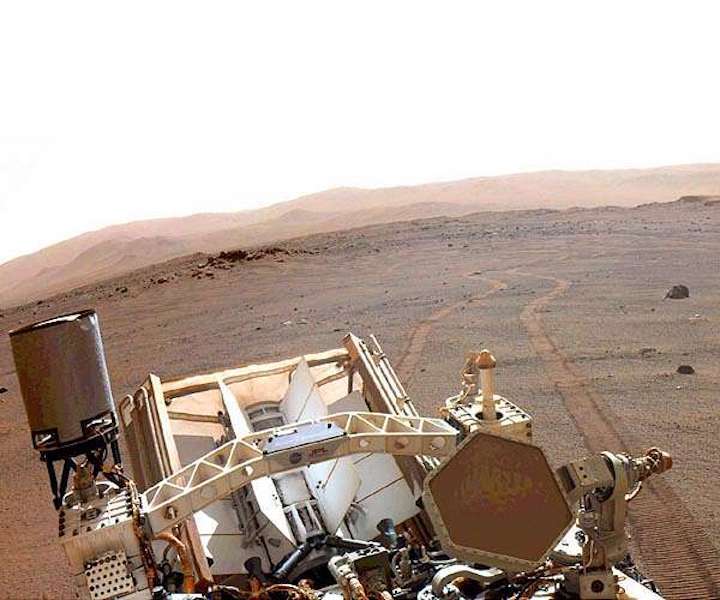
NASA's Perseverance Mars rover looks back at its wheel tracks on March 17, 2022, the 381th Martian day, or sol, of the mission.
The rover's self-driving capabilities will be put to the test this month as it begins a record-breaking series of sprints to its next sampling location.
NASA's Perseverance Mars rover is trying to cover more distance in a single month than any rover before it - and it's doing so using artificial intelligence. On the path ahead are sandpits, craters, and fields of sharp rocks that the rover will have to navigate around on its own. At the end of the 3-mile (5-kilometer) journey, which began March 14, 2022, Perseverance will reach an ancient river delta within Jezero Crater, where a lake existed billions of years ago.
This delta is one of the best locations on Mars for the rover to look for signs of past microscopic life. Using a drill on the end of its robotic arm and a complex sample collection system in its belly, Perseverance is collecting rock cores for return to Earth - the first part of the Mars Sample Return campaign.
"The delta is so important that we've actually decided to minimize science activities and focus on driving to get there more quickly," said Ken Farley of Caltech, Perseverance's project scientist. "We'll be taking lots of images of the delta during that drive. The closer we get, the more impressive those images will be."
The science team will be searching these images for the rocks they'll eventually want to study in closer detail using the instruments on Perseverance's arm. They'll also hunt for the best routes the rover can take to ascend the 130-foot-high (40-meter-high) delta.
But first, Perseverance needs to get there. The rover will do this by relying on its self-driving AutoNav system, which has already set impressive distance records. While all of NASA's Mars rovers have had self-driving abilities, Perseverance has the most advanced one yet.
"Self-driving processes that took minutes on a rover like Opportunity happen in less than a second on Perseverance," said veteran rover planner and flight software developer Mark Maimone of NASA's Jet Propulsion Laboratory in Southern California, which leads the mission. "Because autonomous driving is now faster, we can cover more ground than if humans programmed every drive."
How Rover Planning Works
Before the rover rolls, a team of mobility planning experts (Perseverance has 14 who trade off shifts) writes the driving commands the robotic explorer will carry out. The commands reach Mars via NASA's Deep Space Network, and Perseverance sends back data so the planners can confirm the rover's progress. Multiple days are required to complete some plans, as with a recent drive that spanned about 1,673 feet (510 meters) and included thousands of individual rover commands.
Some drives require more human input than others. AutoNav is useful for drives over flat terrain with simple potential hazards - for instance, large rocks and slopes - that are easy for the rover to detect and work around.
Thinking While Driving
AutoNav reflects an evolution of self-driving tools previously developed for NASA's Spirit, Opportunity, and Curiosity rovers. What's different for AutoNav is "thinking while driving" - allowing Perseverance to take and process images while on the move. The rover then navigates based on those images. Is that boulder too close? Will its belly be able to clear that rock? What if the rover wheels were to slip?
Upgraded hardware allows "thinking while driving" to happen. Faster cameras mean Perseverance can take images quickly enough to process its route in real-time. And unlike its predecessors, Perseverance has an additional computer dedicated entirely to image processing. The computer relies on a single-purpose, super-efficient microchip called a field-programmable gate array that is great for computer vision processing.
"On past rovers, autonomy meant slowing down because data had to be processed on a single computer," Maimone said. "This extra computer is insanely fast compared to what we had in the past, and having it dedicated for driving means you don't have to share computing resources with over 100 other tasks."
Of course, humans aren't completely out of the picture during AutoNav drives. They still plan the basic route using images taken from space by missions like NASA's Mars Reconnaissance Orbiter. Then, they mark obstacles such as potential sand traps for Perseverance to avoid, drawing "keep out" and "keep in" zones that help it navigate.
Another big difference is Perseverance's sense of space.
Curiosity's autonomous navigation program keeps the rover in a safety bubble that is 16 feet (5 meters) wide. If Curiosity spots two rocks that are, say, 15 feet (4.5 meters) apart - a gap it could easily navigate - it will still stop or travel around them rather than risk passing through.
But Perseverance's bubble is much smaller: A virtual box is centered on each of the rover's six wheels. Mars' newest rover has a more sensitive understanding of the terrain and can get around boulders on its own.
"When we first looked at Jezero Crater as a landing site, we were concerned about the dense fields of rocks we saw scattered across the crater floor," Maimone said. "Now we're able to skirt or even straddle rocks that we couldn't have approached before."
While previous rover missions took a slower pace exploring along their path, AutoNav provides the science team with the ability to zip to the locations they prioritize the most. That means the mission is more focused on its primary objective: finding the samples that scientists will eventually want to return to Earth.
Quelle: SD
----
Update: 24.03.2022
.

